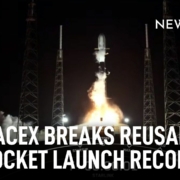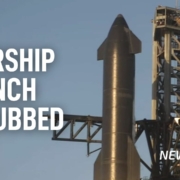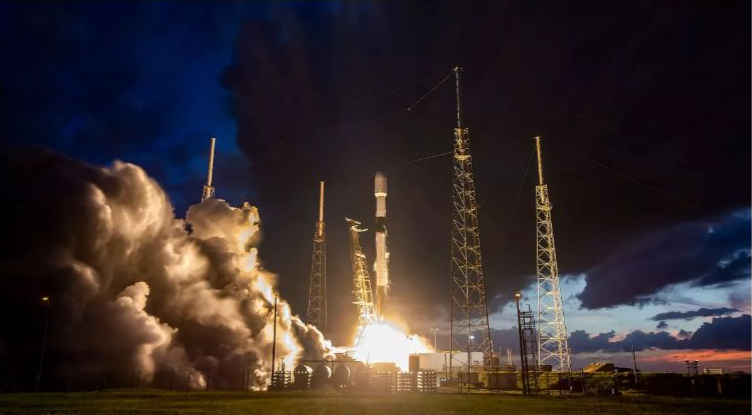Starship 6 Test
SpaceX conducts its sixth test of Super Heavy booster (Booster 13) and Starship (Ship 31) at Starbase, Texas. The test focusses on operational improvements, including experiments with the heat shield, flying the spacecraft at a steeper reentry angle to gather data on thermal protection system performance. The flight carried a banana as payload. After a successful launch and hot-stage separation, the Booster was diverted to splashdown in the Gulf of Mexico instead of being caught by the Mechazilla arms. Ship 31 reignited one of its Raptor engines in space, and after a flight of 1hr 5 mins completed its splashdown in the Indian Ocean. Musk:
Successful ocean landing of Starship! We will do one more ocean landing of the ship. If that goes well, then SpaceX will attempt to catch the ship with the tower.
Successful ocean landing of Starship!
We will do one more ocean landing of the ship. If that goes well, then SpaceX will attempt to catch the ship with the tower. https://t.co/osFud7XXPo
— Elon Musk (@elonmusk) November 20, 2024
Starship Test 5: Mechazilla arms catch Booster
For its fifth flight test, Starship, consisting of the Super Heavy booster (Booster 12) – powered by 33 Raptor engines – and the Starship spacecraft (Ship 30), lifts off from Boca Chica, Texas. At 2m 40s the Super Heavy booster separates from the Starship spacecraft (Ship 30) using hot-staging. Post-separation, the Super Heavy ascends to 69 km (43 miles) and then executes a boostback burn to reverse its course and return towards the launch site, where it slides horizontally into the Mechazilla launch tower’s 30m “chopstick” arms, completing the first successful Heavy Booster catch.
Meanwhile, Starship continues its suborbital trajectory, reaching an apogee of about 212 km (132 miles) over the Indian Ocean. Despite damage to one of its control flaps, Starship maintains stability using its flaps through re-entry to splashdown in the Indian Ocean, approximately 7,000 km (4,350 miles) from separation. Musk:
Even rockets need hugs
Even rockets need hugs 🥰 pic.twitter.com/oF36F0AvBf
— Elon Musk (@elonmusk) October 14, 2024
Starship Test 4: Succesful splashdowns
SpaxeX conducts the fourth flight test of Starship, comprising the Starship Ship 29 upper-stage and Super Heavy Booster 11. The test successfully achieved its two main objectives: simulate a landing with the Super Heavy booster near the surface of the Gulf of Mexico, and ensure Starship could survive peak heating during atmospheric re-entry. Despite minor engine issues, the flight was considered a success, with successful spashdowns. The test was a step forward from the third test, where both stages were destroyed upon re-entry. Modifications included upgrades to the oxygen tanks for better propellant filtration, enhancements to the Raptor engines for improved reliability, and additional roll control thrusters on the ship. The mission profile omitted certain demonstrations from previous tests but included jettisoning the hot staging ring from the booster, a temporary measure for mass reduction during descent.
The FAA did not require a mishap investigation, a first for Starship flights, indicating that the flight stayed within the parameters of planned and authorized activities.
Musk gives high fives to the SpaceX team and his son, Lil X.
Watch Starship’s fourth flight test → https://t.co/bJFjLCiTbK https://t.co/SjpjscHoUB
— SpaceX (@SpaceX) June 6, 2024
SpaceX breaks reusable rocket launch record
SpaceX breaks its own record, after successfully completing a 16th mission with a reusable rocket. The company launches 22 Starlink satellites aboard the Falcon 9 rocket from the Space Force Station in Cape Canaveral, Florida. It is the 16th launch and landing for the B1058 Falcon 9 rocket booster. SpaceX says it hopes the booster can be used a further four times before finally being scrapped. There are now more than 4,000 active Starlink satellites in orbit around Earth, delivering high-speed internet to users. After the satellites are deployed, Musk writes on Twitter:
Looks like we can increase Raptor thrust by ~20 per cent to reach 9,000 tons (20 million lbs) of force at sea level… And deliver over 200 tons of payload to a useful orbit with full and rapid reusability. Fifty rockets flying every three days on average enables over a megaton of payload to orbit per year – enough to build a self-sustaining city on Mars.
SpaceX launches Euclid Space Telescope
SpaceX launches the Euclid Space Telescope for the European Space Agency. Launching at 11:12 a.m. ET from Space Launch Complex 40 at Cape Canaveral Space Force Station, the rocket’s nine Merlin 1D engines ignited and sent Falcon 9 and Euclid to space. It landed back on Earth just over eight and a half minutes later. This was the second launch for the Falcon 9 Booster 1080. Its first-stage engines burned for just over two-and-a-half minutes before stage separation and eventual ignition of the single Merlin 1D MVac second-stage engine, which performed a burn for just over five minutes. Then followed a nine-minute coast phase, and the second stage reignited for a 90-second engine burn to set up momentum for Euclid to be sent on its way to the Lagrange point 2 transfer orbit. After the 2nd stage coasted for approximately 20 minutes, spacecraft separation took place. SpaceX used brand new fairings for the launch.
200th Falcon 9 booster landing
In a rideshare mission called Transporter-8, SpaceX launches a Falcon 9 rocket containing 72 small satellites from California’s Vandenberg Space Force Base to orbit and lands the returning booster, eight minutes later, back on Earth, marking the 200th booster landing in SpaceX’s history. This is the ninth launch and landing for this particular booster. The rocket’s upper stage continued hauling aloft the 72 payloads, which included “cubesats, microsats, a re-entry capsule and orbital transfer vehicles carrying spacecraft to be deployed at a later time.” The satellites deployed from the Falcon 9’s upper stage, separate over a 24-minute span, beginning an hour after liftoff. Transporter-8 was SpaceX’s second mission in about 14 hours, the eighth small-satellite “rideshare” mission launched by SpaceX, and its third such flight of 2023.
After delivering 72 spacecraft to orbit, Falcon 9 returns to Earth and completes SpaceX’s 200th landing of an orbital class rocket pic.twitter.com/7Aw52C97jk
— SpaceX (@SpaceX) June 13, 2023
SpaceX launches 81st Starlink mission, lands booster at sea
SpaceX successfully launches a Falcon 9 rocket, carrying 56 Starlink spacecraft, from Cape Canaveral Space Force Station in Florida, returning it to Earth less than nine minutes later, landing on the SpaceX drone ship, Just Read the Instructions, in the Atlantic Ocean. This was the 11th launch and landing for this Falcon 9 first stage booster, while Starlink Group 5-9 marks the 81st operation Starlink mission, boosting the total number of Starlink satellites launched to more than 4,400.
Falcon 9’s first stage has landed on the Just Read the Instructions droneship pic.twitter.com/bYvC8sH9NX
— SpaceX (@SpaceX) May 14, 2023
Starship explodes four minutes into second test attempt
After being delayed from April 18, SpaceX makes a second attempt at launching Starship. After a short countdown hold at 40 seconds the spacecraft launches and clears the tower. Four minutes into the flight, at a height of 34km, the vehicle explodes, after the second stage fails to separate. Musk congratulates the team:
Congrats @SpaceX team on an exciting test launch of Starship! Learned a lot for next test launch in a few months.
Congrats @SpaceX team on an exciting test launch of Starship!
Learned a lot for next test launch in a few months. pic.twitter.com/gswdFut1dK
— Elon Musk (@elonmusk) April 20, 2023
Starship launch scrubbed
The first Starship launch is scrubbed, ten minutes before launch, due to a pressurant valve being frozen. The countdown continues as a ‘wet dress rehearsal’, to T minus 40 seconds. Another launch attempt may happen in the next 48 hours.
A pressurant valve appears to be frozen, so unless it starts operating soon, no launch today
— Elon Musk (@elonmusk) April 17, 2023
Musk ‘not saying’ Starship will get to orbit
SpaceX will debut its Starship vehicle in a month or so, but the chances of its first-ever orbital mission being a success are apparently only about 50%.
I’m not saying it will get to orbit, but I am guaranteeing excitement. So, won’t be boring!…So I think we’ve got, hopefully, about an 80% chance of reaching orbit this year. It’ll probably take us a couple more years to achieve full and rapid reusability.
According to Musk, Starship will be the most powerful rocket to ever fly, featuring about 2.5 times more thrust at liftoff than NASA’s Saturn V. SpaceX hopes that, among other things, Starship will get people and cargo to the moon and Mars. It is designed to be fully and rapidly reusable, which Musk considers the most important breakthrough for making Mars colonization and other ambitious exploration feats feasible.
Falcon 9 launches 52 Starlink satellites to orbit
SpaceX launches 52 Starlink satellites to orbit, on a Falcon 9 rocket. The launch was SpaceX’s 43rd orbital mission this year. Viewers close by the launchpad witnessed Falcon 9’s first stage falling back to Earth for a soft landing atop the SpaceX droneship, A Shortfall of Gravitas, which was stationed in the Atlantic Ocean. The company has already sent nearly 3,400 Starlinks into space and has a plan to bring thousands more aloft.
Falcon 9 launches 52 Starlink satellites to orbit pic.twitter.com/A4eGu4lmz0
— SpaceX (@SpaceX) September 25, 2022




